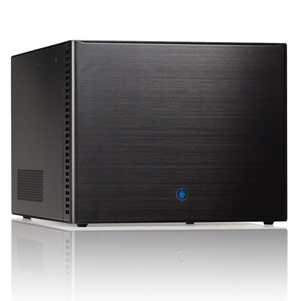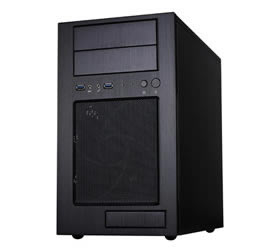File Server Builder's Guide
by Zach Throckmorton on September 4, 2011 3:30 PM ESTAs motherboard layout is important in ensuring that airflow is as unobstructed as possible, case design is also critical in facilitating excellent airflow. If you're building a system with one or two hard drives, most cases work fine for a home file server - just make sure there is a fan near the hard drive(s) so it is not sitting in stagnant air. However, if your server requires multiple disks, here are a few cases that work especially well for file servers.
Mini-ITX

Fractal's Array R2 is a nearly perfect home file server case. At less than 14" deep by 10" wide by 8" tall, it occupies little volume. It positions a removable hard drive cage immediately behind a quiet yet powerful 140mm intake fan. The hard drive cage accommodates up to six hard drives using vibration-dampening silicone mounts, and there is also room for a 2.5" drive (either an SSD or HDD). According to my testing, when stuffed with six low-rpm 2TB mass storage HDDs and one SSD (with an Intel Pentium G620 CPU installed), the temperatures of the HDDs hover around 40C even when all drives are under artificial sustained load (using Iometer). The PSU is a custom SFX form factor model, 80+ efficiency 300W unit with ample amps on the split 12V rail to power six HDDs. The PSU features seven SATA connectors and one legacy molex connector, so there are no extraneous molex plugs and enough SATA plugs. Furthermore, the cables are shorter than typical, so excessive cabling does not interfere with airflow. The case itself is constructed of aluminum so it is lightweight, and its overall build quality is very high. It does not have room for an optical drive, but I consider optical drives superfluous for a home file server. If necessary, you can always hook up a USB interface external optical drive. The only drawback of this case and its PSU is the price: at just under $200, it is not cheap. However, the subjective aesthetics, objective functionality of the case and the custom PSU are worth the cost if you want a small but capacious home file server case.
Micro-ATX

As I prefer home file servers that take up as little space as possible, Silverstone's TJ08B-E is a great, smaller micro-ATX minitower. It's less than 16" deep, 9" wide, 15" tall and weighs less than 12 pounds. It can accommodate up to five HDDs plus one SSD. As with the Fractal Array R2, the hard drives are placed immediately behind a front intake fan - though in this case, it's an even larger 180mm unit. The TJ08B-E is flexible in that it can hold a couple optical drives as well as a GPU in case you want to repurpose or multipurpose it. When stuffed with four low-rpm green drives, the temperatures under load don't exceed 45C during sustained transfers. Overall build quality is very good, like most Silverstone cases.
Silverstone makes a diminutive, fully modular PSU that makes working with smaller cases like the TJ08B-E, Lian Li PC-Q08, and others much easier. Silverstone also offers a short cable kit, making the ST50F-P PSU even better suited to SFF cases. Finally, it's clear that Silverstone had smaller multi-HDD systems in mind when designing the CP06 SATA power plug extension cable. This extender connects to a single SATA power plug and then has four SATA power plugs that are spaced closer than usual together, further reducing cable clutter. Though the cost of these accessories adds up, they make an ideal cabling solution very easy to implement. Regardless of whatever PSU you decide to go with, if you use a split 12V rail model, make sure you don't load up one rail with HDDs. If you go with a single 12V rail model, you'll want that rail to be beefy - for example, don't try to put ten HDDs and four case fans on a budget PSU with a 20A 12V rail.
Full Tower
Very few cases can accommodate ten HDDs at stock (without adding adapters), and such cases are not at all small. Full towers also typically offer excellent airflow, and cable management is not very difficult. Fractal's Define XL is one of the least expensive 10 HDD bay full tower cases available. It is well-built, and extra care has been paid to making the case quiet in the form of panel insulation. It is impossible to hear active HDDs inside this case even when you're sitting just a few feet from it (even the notoriously loud VelociRaptors). Further, there are plenty of integrated niceties like adjustable/flexible cable baffles that assist in cable management. Seven of the ten HDD slots are immediately behind fans, with three slots one cage removed from the front intake fans. Even still, the HDDs that aren't right behind the fans stay cool (between 35C and 40C). At around $150, it is an excellent value. Just make sure you don't pair it up with Silverstone's short cable kit!
We've saved the most important aspect of a home file server - the hard drives - for the next and last component page.











152 Comments
View All Comments
Emantir - Sunday, September 4, 2011 - link
Im using my file server since october'10 it consists of:- Lian Li PC-Q08
- Zotac NM10 DTX Wifi
- 200GB Matrox Sata HDD (System)
- 4x 2TB Western Digital WD20EARS (Storage)
- Asus EN210 Silent
Sporting Ubuntu 10.10 with Software Raid 5 and XBmC for HD Playback, works like a charm.
XBmC Remote Apps exist for iOS and Android so i skipped buying a MCE Remote.
Emantir - Sunday, September 4, 2011 - link
Uh, forgot the Problems:- Asus EN210 blocks one Sata Port
- There are some problems concerning the JMicron Sata Multiplier and Linux. one drive gets miserable write speeds, thus making the whole raid 5 somewhat slow. More: http://goo.gl/cM0gg
Lonyo - Sunday, September 4, 2011 - link
Does the NM10 support staggered spin-up of hard drives?Emantir - Sunday, September 4, 2011 - link
AFAIK No, Im using a 300W PSU anyway, thus high initial current isn't a Problem.pvdw - Monday, September 5, 2011 - link
But you should have a good quality PSU to give nice clean, reliable current. Loads of PSUs are just rubbish.Lonyo - Sunday, September 4, 2011 - link
You may have mentioned needing a good power supply, but when you talk about Atom and Zacate boards, low power solutions, and low power "green" drives, you don't focus on the fact that total system power use in typical conditions could be lower than 30w. If you are buying a beefy 500w power supply, you could be wasting a LOT of power due to efficiency issues.The 80PLUS rating only tests as low as 20% of full load. 30w on a 500w PSU is below 10% load, so you could be getting 70% efficiency.
While it's not a major concern, if you are looking to make things low power to leave it on 24/7, you might want to think about some DC power supplies rather than regular desktop power supplies.
If you are making a 2~4 drive file server based on an Atom system, you could get a 100~120w picoPSU instead of a "real" PSU, and get potentially much higher efficiency than with a 300w+ normal PSU.
Of course, not everyone (especially Americans) cares about efficiency, since for them power is so inexpensive, but for a 24/7 box, why not at least discuss things which might improve power efficiency?
jtag - Sunday, September 4, 2011 - link
I have to say that a file server guide that mentions RAID/NAS really should include a discussion on which drives are suitable for using in a RAID. Not all drives are valid for use in a RAID, not because of reliability concerns, but rather because not all manufacturers support Error Recovery Control (see http://www.csc.liv.ac.uk/~greg/projects/erc/ for more info) in their consumer level drives.I'd very much appreciate it if AnandTech could run the following command on every drive they test and add it to bench, so we could come up with a list of drives that do support ERC:
smartctl -l scterc /dev/sdX
smartctl is available for both Windows and Linux (smartmontools.)
Of course, this may say it is supported, but the real test would be to set timeouts:
smartctl -l scterc,70,70 /dev/sdX
And then cause the drive to have a block error and see if access times out, or causes the drive to drop out of the RAID. This would also be a good test of RAID controller cards, though personally I always use software RAID under Linux.
jtag - Sunday, September 4, 2011 - link
And for the record - I run 6 2TB drives in a RAID-6 (2 drive redundancy) with one hot spare under Gentoo Linux software RAID. My drives are 5 Seagate ST32000542AS and one Samsung EcoGreen F4 HD204UIjwilliams4200 - Sunday, September 4, 2011 - link
Any tips on how to "cause the drive to have a block error"?Rick83 - Monday, September 5, 2011 - link
you can use hdparm to mark a block as faulty, IIRC.